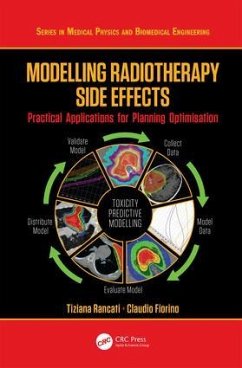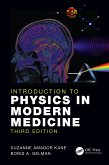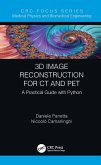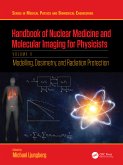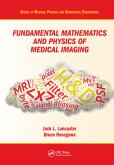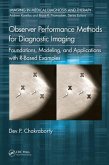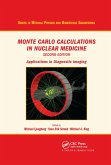Tiziana Rancati, Claudio Fiorino
Modelling Radiotherapy Side Effects
Practical Applications for Planning Optimisation
Tiziana Rancati, Claudio Fiorino
Modelling Radiotherapy Side Effects
Practical Applications for Planning Optimisation
- Gebundenes Buch
- Merkliste
- Auf die Merkliste
- Bewerten Bewerten
- Teilen
- Produkt teilen
- Produkterinnerung
- Produkterinnerung
This book provides an invaluable tutorial for radiation oncologists, medical physicists, and dosimetrists involved in the planning optimization phase of treatment. It presents a practical, accessible, and comprehensive summary of the fieldâ s current research and knowledge regarding the response of normal tissues to radiation.
Andere Kunden interessierten sich auch für
![Primer on Radiation Oncology Physics Primer on Radiation Oncology Physics]() Eric Ford (University of Washingt Department of Radiation OncologyPrimer on Radiation Oncology Physics113,99 €
Eric Ford (University of Washingt Department of Radiation OncologyPrimer on Radiation Oncology Physics113,99 €![Introduction to Physics in Modern Medicine Introduction to Physics in Modern Medicine]() Suzanne Amador KaneIntroduction to Physics in Modern Medicine59,99 €
Suzanne Amador KaneIntroduction to Physics in Modern Medicine59,99 €![3D Image Reconstruction for CT and PET 3D Image Reconstruction for CT and PET]() Daniele Panetta3D Image Reconstruction for CT and PET68,99 €
Daniele Panetta3D Image Reconstruction for CT and PET68,99 €![Handbook of Nuclear Medicine and Molecular Imaging for Physicists Handbook of Nuclear Medicine and Molecular Imaging for Physicists]() Michael LjungbergHandbook of Nuclear Medicine and Molecular Imaging for Physicists44,99 €
Michael LjungbergHandbook of Nuclear Medicine and Molecular Imaging for Physicists44,99 €![Fundamental Mathematics and Physics of Medical Imaging Fundamental Mathematics and Physics of Medical Imaging]() Jack LancasterFundamental Mathematics and Physics of Medical Imaging51,99 €
Jack LancasterFundamental Mathematics and Physics of Medical Imaging51,99 €![Observer Performance Methods for Diagnostic Imaging Observer Performance Methods for Diagnostic Imaging]() Dev P. ChakrabortyObserver Performance Methods for Diagnostic Imaging233,99 €
Dev P. ChakrabortyObserver Performance Methods for Diagnostic Imaging233,99 €![Monte Carlo Calculations in Nuclear Medicine Monte Carlo Calculations in Nuclear Medicine]() Monte Carlo Calculations in Nuclear Medicine65,99 €
Monte Carlo Calculations in Nuclear Medicine65,99 €-
-
-
This book provides an invaluable tutorial for radiation oncologists, medical physicists, and dosimetrists involved in the planning optimization phase of treatment. It presents a practical, accessible, and comprehensive summary of the fieldâ s current research and knowledge regarding the response of normal tissues to radiation.
Produktdetails
- Produktdetails
- Series in Medical Physics and Biomedical Engineering
- Verlag: Taylor & Francis Ltd
- Seitenzahl: 496
- Erscheinungstermin: 10. Juni 2019
- Englisch
- Abmessung: 260mm x 183mm x 31mm
- Gewicht: 1074g
- ISBN-13: 9781138198098
- ISBN-10: 1138198099
- Artikelnr.: 56850118
- Herstellerkennzeichnung
- Libri GmbH
- Europaallee 1
- 36244 Bad Hersfeld
- gpsr@libri.de
- Series in Medical Physics and Biomedical Engineering
- Verlag: Taylor & Francis Ltd
- Seitenzahl: 496
- Erscheinungstermin: 10. Juni 2019
- Englisch
- Abmessung: 260mm x 183mm x 31mm
- Gewicht: 1074g
- ISBN-13: 9781138198098
- ISBN-10: 1138198099
- Artikelnr.: 56850118
- Herstellerkennzeichnung
- Libri GmbH
- Europaallee 1
- 36244 Bad Hersfeld
- gpsr@libri.de
Claudio Fiorino has more than 20-years of experience as a medical physicist, fully dedicated to radiotherapy, including both routine and development/research aspects. He is member of the Physics Committee of ESTRO (from 2007) and recently elected as member of the ESTRO Board. He is member of the Editorial Board of Physica Medica (EJMP) (2001), Radiotherapy and Oncology (2003), Radiation Oncology (2007); he was Associate Senior Physics Editor of the Int. J. Radiation Oncology Biol Phys (2012-2013) and is actually Associate Editor of Physica Medica (EJMP) since 2014. He received the Italian accreditation for University teaching (Physics: applied) for associate professorship (2013). He is author or co-author of several book chapters and of 167 full papers (Scopus) with, in total, more than 3400 citations, h-index: 35 (Scopus: 01/05/2016). Tiziana Rancati's main activities include development of NTCP models for the description of radioinduced toxicity with engagement in the task force of QUANTEC (Quantitative Analysis of Normal Tissue Effects in the Clinic) and in the task force of PENTEC (Pediatric Normal Tissue Effects in the Clinic). She is a teacher in seminars and courses on radiobiology, statistics and modelling normal tissue reactions following radiation therapy. She is currently member of the editorial board of the World Journal of Clinical Oncology (since 2015). She received the Italian accreditation for University teaching (Physics: applied) for associate professorship (2013). She is author or co-author of book chapters and of 67 full papers ≈1830 citations, h-index=22, Scopus: 12/04/2016).
PART I: DATA AND MODELS.
The importance of the quality of data
Building a predictive model of toxicity: methods.
Potentials and limits of phenomenological models.
PART II: PREDICTING THE RISK OF TOXICITY IN PRACTICE.
Pelvis: rectal and bowel toxicity.
Pelvis: urinary toxicity and sexual dysfunctions.
Abdomen.
Optical structures and ears.
Head and neck: parotids.
Head and neck: structures involved in swallowing and nutritional problems.
Head and neck: larynx and structures involved in dysphonia.
Thorax: lungs and esophagous.
Heart and vascular problems.
Skin and fibrosis.
Bones and hematological toxicity.
Nervous system.
Predicting toxicity in RT: a critical summary.
PART III VISION/CHALLENGES.
Data-sharing and toxicity modeling: a vision of the near future.
Quantitative imaging for assessing and predicting toxicity.
Including the 4th dimension into predictive models of toxicity.
Beyond DVH: 2D/3D based dose comparison to assess predictors of toxicity.
Predictive models and automatic planning: where are we going ?
Including genetic variables in NTCP models. Where are we? Where are we
going?
The importance of the quality of data
Building a predictive model of toxicity: methods.
Potentials and limits of phenomenological models.
PART II: PREDICTING THE RISK OF TOXICITY IN PRACTICE.
Pelvis: rectal and bowel toxicity.
Pelvis: urinary toxicity and sexual dysfunctions.
Abdomen.
Optical structures and ears.
Head and neck: parotids.
Head and neck: structures involved in swallowing and nutritional problems.
Head and neck: larynx and structures involved in dysphonia.
Thorax: lungs and esophagous.
Heart and vascular problems.
Skin and fibrosis.
Bones and hematological toxicity.
Nervous system.
Predicting toxicity in RT: a critical summary.
PART III VISION/CHALLENGES.
Data-sharing and toxicity modeling: a vision of the near future.
Quantitative imaging for assessing and predicting toxicity.
Including the 4th dimension into predictive models of toxicity.
Beyond DVH: 2D/3D based dose comparison to assess predictors of toxicity.
Predictive models and automatic planning: where are we going ?
Including genetic variables in NTCP models. Where are we? Where are we
going?
PART I: DATA AND MODELS.
The importance of the quality of data
Building a predictive model of toxicity: methods.
Potentials and limits of phenomenological models.
PART II: PREDICTING THE RISK OF TOXICITY IN PRACTICE.
Pelvis: rectal and bowel toxicity.
Pelvis: urinary toxicity and sexual dysfunctions.
Abdomen.
Optical structures and ears.
Head and neck: parotids.
Head and neck: structures involved in swallowing and nutritional problems.
Head and neck: larynx and structures involved in dysphonia.
Thorax: lungs and esophagous.
Heart and vascular problems.
Skin and fibrosis.
Bones and hematological toxicity.
Nervous system.
Predicting toxicity in RT: a critical summary.
PART III VISION/CHALLENGES.
Data-sharing and toxicity modeling: a vision of the near future.
Quantitative imaging for assessing and predicting toxicity.
Including the 4th dimension into predictive models of toxicity.
Beyond DVH: 2D/3D based dose comparison to assess predictors of toxicity.
Predictive models and automatic planning: where are we going ?
Including genetic variables in NTCP models. Where are we? Where are we
going?
The importance of the quality of data
Building a predictive model of toxicity: methods.
Potentials and limits of phenomenological models.
PART II: PREDICTING THE RISK OF TOXICITY IN PRACTICE.
Pelvis: rectal and bowel toxicity.
Pelvis: urinary toxicity and sexual dysfunctions.
Abdomen.
Optical structures and ears.
Head and neck: parotids.
Head and neck: structures involved in swallowing and nutritional problems.
Head and neck: larynx and structures involved in dysphonia.
Thorax: lungs and esophagous.
Heart and vascular problems.
Skin and fibrosis.
Bones and hematological toxicity.
Nervous system.
Predicting toxicity in RT: a critical summary.
PART III VISION/CHALLENGES.
Data-sharing and toxicity modeling: a vision of the near future.
Quantitative imaging for assessing and predicting toxicity.
Including the 4th dimension into predictive models of toxicity.
Beyond DVH: 2D/3D based dose comparison to assess predictors of toxicity.
Predictive models and automatic planning: where are we going ?
Including genetic variables in NTCP models. Where are we? Where are we
going?

